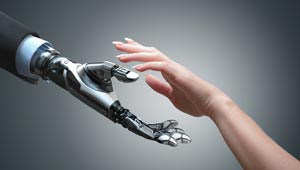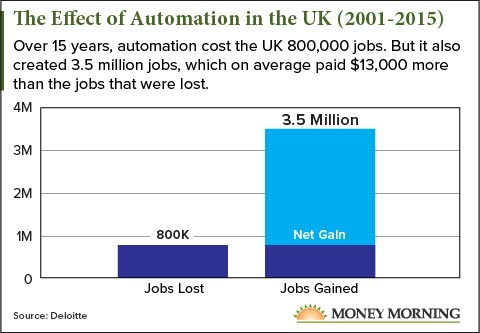The idea of a robot invasion first triggered anxieties around 200 years ago, when textile workers in England called "Luddites" destroyed factory machinery that they feared would replace them. The name has come to describe opposition to all forms of technology, but the original Luddites were merely concerned with saving their livelihoods.
 The reality of a robot takeover today is less threatening. When machines can be used to perform tasks that previously required humans, it not only gives those humans the freedom to be more productive, it also creates entirely new economic opportunities that didn't exist before.
The reality of a robot takeover today is less threatening. When machines can be used to perform tasks that previously required humans, it not only gives those humans the freedom to be more productive, it also creates entirely new economic opportunities that didn't exist before.
And that means new opportunities for investors, too.
"People instinctively fear change," Money Morning Chief Investment Strategist Keith Fitz-Gerald says, "especially when it comes to robots, which are not well understood.
"What they forget is that robots are not just about productivity. They're also about progress, which means, from an investment standpoint, what you really want to be thinking about is how you harness that."
With that in mind, we've got three stock picks for you that are already using automation not just to lower costs, but to expand the capacities of their human employees, expand their enterprises, and deliver better products and services to customers.
But first, let's look at this myth of a robot-dominated dystopia...
Here's the "Dystopian" Future We're Headed For
Imagine a distant future when we've achieved maximum automation; when the "robot invasion" is complete and is old news. Machines dominate our - or, rather, our great-grandchildren's - lives.
- Food is delivered to us in restaurants via automated conveyors and delivered to us at home via driverless vehicles.
- That same food is harvested by machines, which can then load it onto driverless trucks for transport.
- Transportation of any kind, short distance or long distance, requires no drivers, no pilots, no conductors, and no captains.
- To the extent that we ever go to brick-and-mortar stores, they are stocked by machines and require no cashiers. The Internet of Things means we can just grab an item and get an electronic bill automatically.
This is not a dystopia in which robots have completely replaced humans.
True, it's a lot of machines doing a lot of work. But we're going to need a lot of people whose jobs are to install, train, oversee, and repair the millions and millions of machines in the world.
And given the value of those machines and the wealth they generate, those jobs working with them should fetch pretty enviable salaries and benefits.
This new class of workers is going to demand high-quality goods and services, creating brand-new opportunities for...
- Chefs and agricultural specialists to create high-quality foods
- Artists, producers, hosts, and event planners to create high-quality entertainment
- Tourism and hospitality professionals to create high-quality travel options
- Architects and interior designers to create high-quality places to live and work
- Product designers of all kinds to create high-quality devices, games, and software
- Teachers and counselors to provide a high-quality education, empowering the next generation to meet the demands of the new economy
- A slew of professionals in fields no one has even imagined yet
In other words, forget about mass unemployment. Robots are job creators, not job destroyers.
That's borne out by a Deloitte study that found that, while automation had eliminated 800,000 jobs in the United Kingdom over 15 years, it had also created 3.5 million new jobs. Those new jobs paid an average of $13,000 more than those that were eliminated and provided a net boost of $185 billion to the economy.

Mass Unemployment Make No Sense - and That's Important for Investors
If robots were really putting us on a path to mass unemployment, they would end up producing a whole lot of products that nobody could afford to buy.
The economy as we know it would die.
That would be devastating for investors, too, since businesses depend on consumers to thrive.
It is true, of course, that the work people will be doing in the future is different than what it is today. And that's scary in the transition period.
After all, if you told someone a century ago that we would soon be able to produce more food than ever before with a fraction of the agricultural labor force that existed at that time, you probably wouldn't get a friendly reaction.
But we're much more prosperous today than when the majority of the population worked on farms.
Breaking: California Marijuana Legislation Sparks the Most Profitable Opportunity of 2018. Click Here for Details...
Likewise, the transition away from jobs that can be automated may seem scary, but some companies are already finding new ways to make their employees more useful in the robot age. Because they value the ingenuity and adaptability of the people working for them, these are the companies that are going to get the most out of the rise of the machines and deliver the biggest gains for shareholders.
Let's take a look at them now...
This Company Has Transformed the Retail Sector and Is Still Expanding at a Blistering Pace
[mmpazkzone name="in-story" network="9794" site="307044" id="137008" type="4"]
The "Retail Ice Age" has been a major theme of 2017, as brick-and-mortar stores have been closing left and right. Traditional retailers like Sears Holdings Corp. (Nasdaq: SHLD) and JC Penney Co. Inc. (NYSE: JCP) have watched their share prices fall significantly over the last year.
It's no secret who the culprit is. Amazon.com Inc. (Nasdaq: AMZN) has changed the face of retail as we know it.
Not everybody is happy about it. U.S. President Donald Trump himself has lashed out at the online retail giant for the "many jobs being lost" due to e-commerce.
Yes, it's true that traditional retail has shed 140,000 jobs in the last decade. But according to a September 2017 report from the Progressive Policy Institute, e-commerce added 400,000 jobs in that time. Even better, those jobs on average pay 31% more than the equivalent brick-and-mortar jobs.
Amazon, the biggest source of those new jobs, has seen its stock rise from $90 to over $1,100 in the past decade. And it hasn't stopped with simply automating the shopping experience.
"In other words, the robots are not so much replacing humans as maximizing their productive potential."
In 2012, Amazon purchased robotics company Kiva Systems for $775 million and rebranded it "Amazon Robotics." Over the past three years, the online retailer has rolled out 100,000 robots into its warehouses.
And yet, Amazon is not only not cutting jobs, it's hiring at a frenetic pace. The company has hired 80,000 new workers since introducing warehouse robots and is currently soliciting bids to open a second headquarters, where it expects to hire an additional 50,000 people.
That's because the business is expanding, which is what happens when productivity goes up. The robots do the most repetitive tasks, like stacking bins and transporting pallets, while humans work with them doing tasks that require more dexterity and adaptability.
In other words, the robots are not so much replacing humans as maximizing their productive potential.
The result: Amazon stock is up more than 50% in 2017 and shows no signs of slowing down.
The company's robotics division is aiming to bring more automation into the warehouse in the coming years, as well as to the delivery end. Amazon completed its first drone delivery in the UK last year.
Amazon's entire business model is based on finding efficiencies that others miss or are slow to incorporate. So you can bet that as technology opens up new opportunities for the company to streamline and expand its business, it will pounce.
That's why, as Keith Fitz-Gerald says, there's no such thing as an Amazon-proof retailer.
E-commerce is a great example of the knock-on effect of automation. Not only does Amazon use automation to increase its own efficiency, it also increases the efficiency of its customers. The Progressive Policy Institute estimates that e-commerce has saved American households 64 million hours per week in shopping time. That's the equivalent of 1.6 million full-time jobs.
In short, Amazon makes us all more productive, which allows us to create more wealth. That's why customers will happily ditch the brick-and-mortar stores and keep returning to Amazon again and again.
Keith writes: "Amazon may well be the only company in the world today that you can buy now and expect to hold for the rest of your investing lifetime."
At more than $1,100 per share, this stock may look expensive. But in a few years, that will look like an unbelievable bargain.
This Coffee Company's First Step Toward Automation Is Already Delivering Results That Even Apple Envies
According to the McKinsey Global Institute, the sector with the most automation potential is accommodation and food services. In fact, fast food chains like McDonald's Corp. (NYSE: MCD) and Wendy's Co. (Nasdaq: WEN) have already started rolling out self-ordering kiosks to replace cashiers.
We can definitely expect to see more automated food service, not just in fast food restaurants, but eventually even in fine dining establishments.
But robots simply doing a job a human used to do without adding any new benefits is not necessarily a game changer that will send profits soaring. The real benefits of automation come when you enable humans to do more.
And one company in food and beverage service has been doing just that: Starbucks Corp. (Nasdaq: SBUX).
The Seattle-based coffee company hasn't unveiled robo-baristas just yet. But it has done what Apple Inc. (Nasdaq: AAPL), Alphabet Inc. (Nasdaq: GOOGL), and eBay Inc. (Nasdaq: EBAY) haven't been able to do: run a successful mobile payment app.
Free Book: The secrets in this book helped one Money Morning reader make a $185,253 profit in just eight days. Learn how to claim your copy here...
30% of Starbucks' sales are now paid for via its mobile phone app, and 10% are ordered ahead of time with the app. Those mobile users become part of a system that enables efficient target marketing and inspires loyalty thanks to rewards based on points - or "stars" - that customers collect.
As this catches on, it means baristas spend less time behind a cash register and more time doing what they're good at: making drinks and interacting with customers.
The 13.3 million customers who are enrolled in "My Starbucks Rewards" accounted for 36% of sales last quarter. That confirms Keith's assessment that a program like this "leashes or tethers the customer to the brand" so they keep coming back.
"Starbucks' move," Keith says, "is a perfect example of innovation from a company that has two choices - get on board, or get left behind."

Machines that can make coffee drinks have been around for years now, but Starbucks surely recognizes that coffee shops provide people something more than just hot beverages. So even as automation technology inevitably creeps into the retailer's front of house, look for Starbucks to find new ways for its employees to offer customers more for less.
And best of all, its rewards program, run through its mobile app, means Starbucks can collect and use data efficiently.
This coffee maker was always nice to have in your portfolio - the stock has more than doubled in the last five years. But according to Keith, this new development turns SBUX from a "nice-to-have" into a "must-have."
This Automaker Pioneered Robot-Assisted "Lean Production" - Now It Trains Humans to Improve Robot Performance
With more than 300,000 industrial robots, Japan is the center of the automation world. You won't find too many Japanese citizens biting their nails over it, either.
The country's aging demographic mean the economy needs robots to replace people just to maintain any level of growth. That's why Japanese Prime Minister Shinzo Abe introduced sweeping deregulation in 2014 in hopes of tripling the robotics market from $7 billion to $21 billion by 2020.
So it's no surprise that Japan's largest auto manufacturer, Toyota Motor Corp. (NYSE: TM), has been a leader in developing robots for its manufacturing processes going back to the 1970s. The company even has its own robotics division that has produced a series of humanoid robots meant to assist in home services, healthcare, construction, and even space travel.
What is surprising, though, is the way Toyota has been rethinking its automation processes over the last several years, sometimes even replacing robots with humans.
Toyota's manufacturing model, based on the idea of "lean production," has been the envy of the automotive world for decades. But today, the company is less focused on creating a fully automated assembly line - as Elon Musk's Tesla Inc. (Nasdaq: TSLA) is - and more focused on how to get robots and humans to work together to raise the level of craftsmanship.
In other words, Toyota wants to make cars not only cheaper, but better.
In pursuit of that goal, Toyota has even gone so far as to de-automate processes at some of its factories so its employees can master the craft of assembling a car. These employees, the company figures, are ultimately going to be the people who train robots on the line, identify problems, and know how to fix them before they become catastrophes.
The investment in humans who can work intelligently with robots is paying off. In September, Fast Company shared how Toyota workers in Georgetown, Ky., built their own device to automate the grueling task of installing a gas tank. Freed from the more labor-intensive work, they were able to focus more on quality control to prevent critical defects down the line.
This kind of ingenuity at every level in the organization is a big reason why Toyota has consistently enjoyed the best profit margins in the industry. It's possible that Elon Musk's vision of a "lights out" assembly line (i.e. one that would require no lights because it has no humans) will become a reality one day. But expect Toyota to use automation not just to cut costs but to find ways to keep putting new, higher-quality products on the market.
You Could Bank $800,000 in One Year Thanks to This Simple Method
You can turn a small stake into $815,588 in just one year with our new, fast-money research service.
The "accelerator trading strategy" is designed to take the emotion out of trading - and to help you make money.
And it works.
This year, we've already shown our readers 45 triple-digit gains. In October, accelerator trades averaged 313% gains a week, including full and partial closeouts.
Don't wait. Space is limited, and we're releasing four new moneymaking recommendations every week. Get your shot at 313% average weekly gains here...
Follow Money Morning on Twitter @moneymorning, Facebook, and LinkedIn.
About the Author
Stephen Mack has been writing about economics and finance since 2011. He contributed material for the best-selling books Aftershock and The Aftershock Investor. He lives in Baltimore, Maryland.



